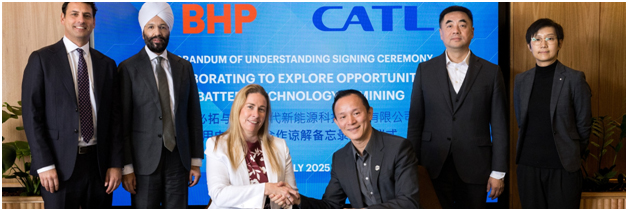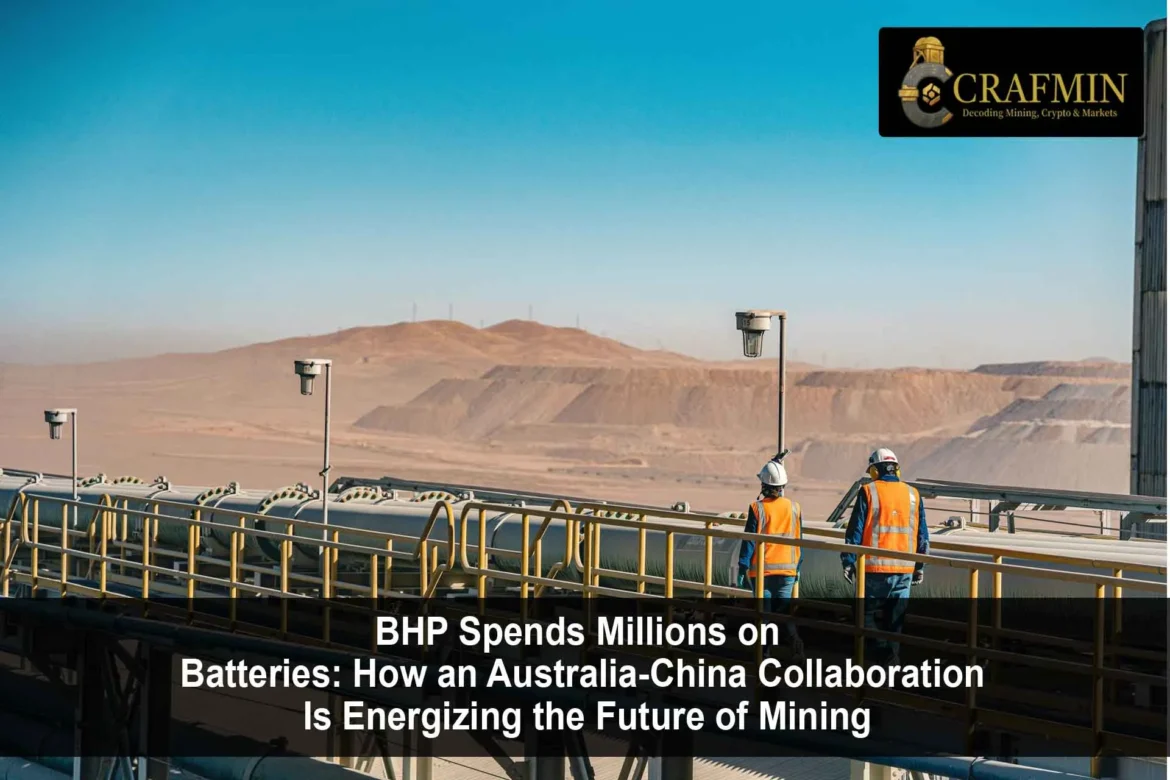
Source: BHP
In a step that could revolutionize mining vehicles, BHP has made big headlines by committing to historic terms with Chinese battery behemoths BYD and CATL to introduce battery-electric vehicles and charging points at its Western Australian mines.
This is not merely an expansion of technology—it’s a strategic pivot in the global mining behemoth’s attempt to decarbonise its colossal operations, beginning with Australia’s mineral economy’s red heart: the Pilbara.
A Pivot That Can Transform Mining’s Carbon Footprint
Australian mining has relied on diesel—the dynamo of trucks, loaders, and trains that move ore across the vast outback—for years. That story is now changing.
Through this BHP CATL BYD collaboration, among the world’s most carbon-intensive mine operations will soon be embracing a new era of battery-powered mining gear-from electric heavy-haulage trucks to customized charging systems for demanding environments.
Whereas Fortescue and Rio Tinto have been experimenting with hydrogen and hybrids, BHP is going more electrified. Investing in going directly to the world’s two largest battery makers sends a clear message: the future of mining will not be fossil-fueled.
A New Approach: It’s Not All Green Targets—It’s Sovereignty
Sovereignty over energy is one of the lesser-talked-about, but very strategic aspects of this tie-up.
Australia’s mining industry has long been dependent on imported diesel. With increasingly volatile global fuel supply chains, particularly in the context of geopolitical upheaval, transitioning to battery-based infrastructure provides more than carbon reduction—it provides control of energy.
By putting in EV charging infrastructure in the remote sites and developing on-site renewables, BHP is cutting its energy future to size. These adjustments may one day insulate miners from the threat of diesel price swings and global freight shocks—while energizing the country’s resilience through the world’s energy transition.
From Ore to Outlet: What Will This Electrification Look Like?
The pilot program will have three pillars, sources close to the rollout plan indicate
Battery-Electric Haul Trucks: Custom-designed for Pilbara mine land’s rugged terrain and blistering heat. Not off-the-rack Teslas—200-tonne behemoths designed for long hauls and sharp grades.
Charging Infrastructure: Quick charging points, perhaps solar-powered, will be built close to major iron ore processing facilities such as Newman and Port Hedland. They must be mobile and modular, responsive to shifting mine layouts.
Battery Lifecycle Management: BYD’s recycling know-how will be combined with CATL’s energy storage technology to maintain sustainability throughout the product life cycle—a challenge that is normally underplayed in EV launches.
It’s a synchronized but technologically advanced endeavor, one that underscores the growing sophistication of planning for electrifying mining.
Also Read: Speakman Wants AI in Schools. Here’s What That Means for NSW
Western Australia: The Mining Innovation Centre
Western Australia is, undoubtedly, leading the way in the mining revolution. Pilbara produces huge amounts of the world’s iron ore, much of which goes into the very steel that makes up EVs, turbines, and solar farms.
And the same area today will become the world’s test bed for industrial electrification – a natural progression given WA’s vast renewable resource, enough political support, and skilled mining workforce.
The state government has already laid down infrastructure to support battery technology and hydrogen demonstrations. We can expect that BHP’s new evolution will accelerate those plans – and potentially create new export-ready skills.
The Human Impact: Reskilling for the EV Era
And there is another transition happening: the workforce. As BHP deploys electric vehicles throughout its operations, it will retrain diesel mechanics to become EV technicians, train maintenance crews on battery diagnostics, and cultivate its pipeline talent into electrical engineering disciplines.
It is likely that apprenticeship programs will include instruction about battery health analytics and smart grid integration so that local talent is not left behind in the shift. This is not just a machinery shift, but a workforce shift.
Troubled Waters: Scaling Right at the Outback
Steering through these complications with BHP’s high-tech partners does not mean that they are immune to challenges.
Charge Time vs Uptime: This really means the equipment is working 24/7. If fast-charging is too slow to bring equipment back into work, they could consider battery swap systems.
Grid Reliability: While microgrids and solar projects are underway, the desire for reliable power equally necessitates solving power as a technical challenge particularly in isolated locations.
Regulatory Lag: The Government could be distracted by the mine electrification policy, carbon credits, and integration of infrastructure, which might need faster changes to create mass deployment in an industry leading away from fossil fuels.
Regardless, none of these are showstoppers – they are engineering challenges which companies such as BHP, CATL, and BYD are better suited to solve.
Why This Moment Matters
BHP’s very public, very ambitious transition to battery-powered mining isn’t just a response to ESG requirements, it’s a deliberate and well-thought-through move. The market, the regulators, and future generations are all watching—and rewarding trailblazers.
As the climate crisis intensifies and global investors ramp up their intolerance for carbon-intensive enterprises, we are getting reminders that mining can be innovative and profitable.
Conclusion: From Diesel Behemoths To Electric Trailblazers
The BHP CATL BYD partnership is a turning point—not just for BHP, but for the mining sector as a whole. Change doesn’t usually happen quickly in mining, in an industry characterized by depth, speed, and scale it usually takes an eternity. Not today. The wheels are now spinning faster—and they are electric.
The future of mining in Australia is happening sooner rather than later. And it’s quietly, efficiently, and battery-powered.

